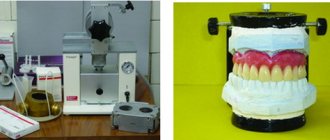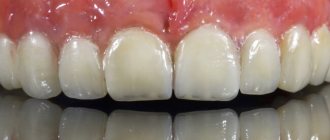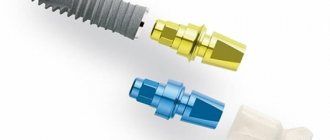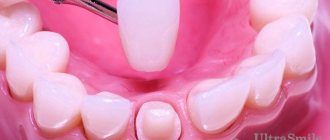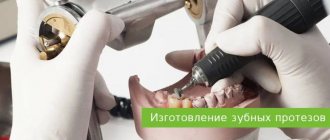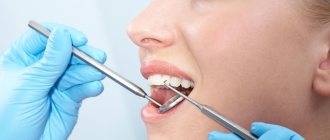The stages of making a clasp denture is a procedure that involves a professional and careful approach in dentistry. As a result of the step-by-step process, a product is obtained that successfully replaces implants and restores the dentition. The design is indicated for certain disorders and in the absence of natural units in the dentition. It is installed during the period of preparation for prosthetics to maintain aesthetics, correct deep bites, as well as for the treatment of periodontal disease and bruxism. Clasps have a number of advantages and, with proper care, last a long time. Modern orthopedic dentistry offers several types of clasps, for the manufacture of which special materials are used.
What is a clasp?
The clasp is a titanium, chromium-cobalt or gold-platinum frame in the shape of an arc with special fasteners. The main advantage of such dentures is their ability to rest not only on the gums, but also on the body of the jaw, palate, alveolar processes and healthy teeth.
Thanks to this design, the chewing load and pressure are evenly distributed over the entire dentition, preventing the process of loosening and premature loss of healthy teeth.
Nowadays, clasp prosthetics is becoming more and more in demand and popular.
This is due to a noticeable qualitative leap in the production of prosthetics. Modern clasps have a lightweight, durable, openwork design and practical fastenings that are invisible to prying eyes; they are durable, reliable and easy to use.
Purpose of structures
The color and shape of clasp products meet high aesthetic requirements. They help eliminate lingering defects in various parts of the jaw row.
The prosthesis, equipped with locks and attachments, has a one-piece frame with an acrylic base. This design makes it possible to achieve high strength values of the base, so there is no need to create a massive base, which means that the frame and artificial gum will be light in weight.
This makes clasp prosthetics optimal for a patient with partial edentia.
A removable orthopedic device is used as a more advanced alternative to partial plate prosthetics in cases where, due to a complex clinical picture, it is impossible to produce a permanent dental bridge.
Clasp systems are prescribed in a number of clinical cases:
- double-sided end defect (there are no posterior specimens that could become a support for the bridge);
- terminal flaw on one side of the dentition;
- absence of more than 4 copies in the anterior section;
- absence of more than 3 units in the posterior part of the chewing row;
- diseases of the periodontal tissues in combination with problems with the integrity of the dentition;
- multiple pathological changes in the jaw rows;
- severe loose teeth.
Structure and types of clasp dentures
A standard clasp prosthesis consists of a durable frame equipped with supporting, retaining and unloading elements:
- arc;
- fastenings;
- base with artificial plastic or porcelain teeth.
Depending on the type of fastenings, the following types of clasp dentures are distinguished:
- clasp (the device is held in the mouth thanks to special hooks that tightly cover the supporting teeth);
- locking (prostheses are attached to metal-ceramic crowns placed on abutment teeth);
- with a telescopic fixation system (to secure the prosthesis, two interlocking crowns are used, one of them is located on the device itself, and the second is attached to the abutment tooth).
Clasp
Castle
Technologies
The design of the clasps is complex, so they are made only in dental laboratories equipped with special equipment. Two technologies are used for this:
- Casting with removal of the model from the blank. The method involves taking a wax impression from a plaster model and then placing it in a refractory compound. The wax is removed and replaced with liquid metal.
- Casting a refractory sample, during which the base is modeled.
This method has two advantages over previous technology. Firstly, the metal does not “shrink”, and secondly, the possibility of changing the parameters of the wax blank during its removal from the model and packaging into a refractory mass is excluded.
Important! Cast structures are very thin, reliable, lightweight and very accurate, so the period of getting used to them is very short.
Stages of clasp prosthetics
Preparation of prosthetics
Preparation for clasp prosthetics begins with an examination of the patient. Doctors carefully listen to the patient’s complaints and wishes, conduct a dental examination, and study the patient’s medical history. After this, after analyzing the results of the examination, dentists decide on the need for clasp prosthetics.
Treatment of dental diseases
Before the production of the prosthesis begins, teeth that cannot be preserved are removed, periodontal disease and other dental diseases are treated. If there is a pronounced inclination of the abutment tooth or if there are restorations on it, as well as with prosthetics using telescopic or locking fixation, crowns are put on the abutment teeth.
Rules of care
The service life of the system, subject to strict adherence to all rules of care, is approximately 10 years. Also, their implementation will help prevent inflammation of the mucous and periodontal tissues:
- It is good to rinse your mouth with water or mouthwash after each meal.
- Clean the structure twice a day, being sure to remove it before the procedure.
- Treat in the same way as natural teeth, using paste and a classic brush. Highly abrasive pastes should not be used for the procedure.
- Each time after removal, treat with an antiseptic (it is better to do this before going to bed).
- Rinse only with warm water. Do not use alkalis or highly acidic products.
- Eliminate hard and sticky foods from your diet, and avoid hot foods and drinks.
- Protect from accidental falls and breakages.
It is also necessary to perform position adjustments and professional dental cleanings at least once a year.
.
The above rules of care are simple and easy to follow. Compliance with them will ensure the preservation of the functionality of the system and comfort during operation.
Making a prosthesis
All video presentations
Taking an impression
The production of a clasp prosthesis begins with taking a diagnostic impression. This impression is used to create a working model, which the dental technician is guided by when making the frame.
Production of clasps
The most critical stage of work is the production of clasps or crowns with fasteners. The clasps must accurately follow the shape of the patient’s supporting teeth and tightly cover them without damaging the enamel. In turn, the crowns with the mating parts of the locks must completely correspond to the clasp itself with the lock. Precision in the production of fasteners is a guarantee of the durability of the prosthesis and ease of use.
Casting the prosthesis frame
Having completed work on the manufacture of fasteners, the dental technician sketches the frame of the prosthesis and duplicates the working cast, that is, creates a fire-resistant master model. Then the sketch of the future clasp is transferred to a fireproof cast, and casting channels and a flask are installed on it. Gold-platinum, titanium or cobalt-chromium alloys are used to cast the frame.
Installation of artificial teeth and fitting
The finished frame is polished, support-retaining and unloading elements are attached to it, and it is tried on in the patient’s growth cavity. After this, artificial teeth matching the color are installed on the base and re-fitting is performed. On average, the production of a prosthesis takes 2 months.
Material used
All structural elements of the system are made using different materials. So, for the manufacture of the frame and arc, a cobalt-nickel alloy or stainless steel .
The alloy product is hypoallergenic and has a high biocompatibility with periodontal tissues.
Less popular is the system, the parts of which are made of steel. Its disadvantage is that an oxide film forms very quickly at the soldering points (its appearance indicates the beginning of the oxidation process).
The base on which the artificial chewing elements are placed is usually made of acrylic (a type of plastic). Despite the lightness of the material, it is quite durable.
All small elements (including fasteners) are made of titanium, which reduces the overall weight and parameters of the product. It is this fact that reduces the adaptation period to the system to 3-5 days.
For artificial chewing elements, metal-ceramics or ceramics (plastics are used less frequently).
Where does the process of making removable dentures begin, and what material is used?
Find out about the effectiveness of denture retaining spacers here.
At this address https://zubovv.ru/protezirovanie/semnyie-p/komu-podoydut-akri-fri.html you will find a selection of positive and negative reviews about Akri Fri removable dentures.
Advantages and disadvantages of using clasp dentures
Benefits of prosthetics
The main advantages and advantages of clasp prosthetics are:
- durability, reliability and strength of prostheses;
- tenacity of fastening the clasp in the oral cavity;
- the ability to perform prosthetics even if there are only a few teeth in the dentition;
- ease of care for the prosthesis;
- the ability not to remove the clasp at night;
- no discomfort, impaired diction, or inconvenience when eating.
Reviews
The presented type of prosthetics, although considered partly democratic, still remains inaccessible to most patients.
However, this is the best offer that dentistry can recommend today for the stated price. Prosthetics with clasp products are reliable, safe and durable.
You can leave your feedback on the prosthetic technique in the comments to this article.
If you find an error, please select a piece of text and press Ctrl+Enter.
Tags clasp dentures removable dentures
Did you like the article? stay tuned
Previous article
What is unique about Korean Anyridge implants?
Next article
What to do if a splinter remains after tooth extraction
Price
The cost of clasp structures is high in comparison with other removable products. But, despite this fact, their use today is one of the most popular services in dental clinics.
This table provides information on the average cost of various clasp systems. These figures already include payment for oral cavity preparation services.
| Type of prosthesis | Price, thousand rubles |
| Simple for one jaw | from 15 |
| System for 2 jaws | about 25 |
| Splint system | from 20 |
| Micro-lock design | about 40 |
| Product on telescopes | about 70 |
The figures given are subject to change. Their upward fluctuation depends on the complexity of the design itself, the type of material used in production, and the type of fastening used.
